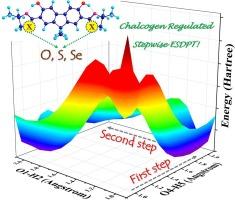Computational detangling chalcogen elements substitutions associated ESDPT mechanism for oxazolinyl-substituted hydroxyfluorene derivatives
IF 4.3
2区 化学
Q1 SPECTROSCOPY
Spectrochimica Acta Part A: Molecular and Biomolecular Spectroscopy
Pub Date : 2024-11-26
DOI:10.1016/j.saa.2024.125493
引用次数: 0
Abstract
In view of the distinguished photochemical and photobiological characteristics of oxazolinyl-substituted hydroxyfluorene and its derivatives, herein, we mainly focus on probing into excited state behaviors of the novel 9,9-dimethyl-3,6-dihydroxy-2,7-bis(4,5-dihydro-4,4-dimethyl-2-oxazolyl) fluorene (Oxa-OH) derivatives. In light of the significant effects resulting from substituting oxygen elements, three Oxa-OH derivatives (i.e., Oxa-OO, Oxa-SS and Oxa-SeSe fluorophores) are considered in this work. For these three different fluorophores, we detangle the effects of atomic electronegativity and charge recombination related to oxygen elements in excited state double proton transfer (ESDPT) processes. Because of the low potential energy barriers, we confirm the ESDPT happens by the sequential type. Based on heterosubstituted Oxa-OS and Oxa-OSe compounds, we further verify the chalcogen atomic-electronegativity-regulated stepwise ESDPT mechanism. We sincerely wish our work could provide a theoretical reference for proving this novel mechanism of ESDPT experimentally.

恶唑啉基取代的羟基芴衍生物与 ESDPT 机制相关的计算消解查耳酮元素取代作用
鉴于噁唑啉基取代的羟基芴及其衍生物具有显著的光化学和光生物特性,我们在本文中主要探讨了新型 9,9 二甲基-3,6-二羟基-2,7-双(4,5-二氢-4,4-二甲基-2-恶唑基)芴(Oxa-OH)衍生物的激发态行为。鉴于取代氧元素会产生重大影响,本研究考虑了三种 Oxa-OH 衍生物(即 Oxa-OO、Oxa-SS 和 Oxa-SeSe 荧光体)。对于这三种不同的荧光团,我们分析了激发态双质子转移(ESDPT)过程中与氧元素有关的原子电负性和电荷重组的影响。由于势能壁垒较低,我们确认 ESDPT 是以顺序方式发生的。基于异质取代的 Oxa-OS 和 Oxa-OSe 化合物,我们进一步验证了查尔根原子-电负性调控的逐步式 ESDPT 机制。我们衷心希望我们的工作能为实验证明这种新颖的 ESDPT 机制提供理论参考。
本文章由计算机程序翻译,如有差异,请以英文原文为准。
求助全文
约1分钟内获得全文
求助全文
来源期刊
CiteScore
8.40
自引率
11.40%
发文量
1364
审稿时长
40 days
期刊介绍:
Spectrochimica Acta, Part A: Molecular and Biomolecular Spectroscopy (SAA) is an interdisciplinary journal which spans from basic to applied aspects of optical spectroscopy in chemistry, medicine, biology, and materials science.
The journal publishes original scientific papers that feature high-quality spectroscopic data and analysis. From the broad range of optical spectroscopies, the emphasis is on electronic, vibrational or rotational spectra of molecules, rather than on spectroscopy based on magnetic moments.
Criteria for publication in SAA are novelty, uniqueness, and outstanding quality. Routine applications of spectroscopic techniques and computational methods are not appropriate.
Topics of particular interest of Spectrochimica Acta Part A include, but are not limited to:
Spectroscopy and dynamics of bioanalytical, biomedical, environmental, and atmospheric sciences,
Novel experimental techniques or instrumentation for molecular spectroscopy,
Novel theoretical and computational methods,
Novel applications in photochemistry and photobiology,
Novel interpretational approaches as well as advances in data analysis based on electronic or vibrational spectroscopy.

 求助内容:
求助内容: 应助结果提醒方式:
应助结果提醒方式:


